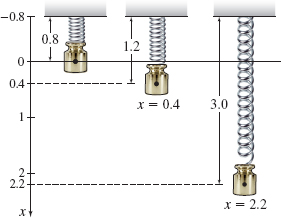EXAMPLE 2Analyzing a Spring Force
Suppose a spring in equilibrium is 0.8 m long and a spring force of 2 N stretches the spring to a length of 1.2 m.
- (a) Find the spring constant k and the spring force F.
- (b) What spring force is required to stretch the spring to a length of 3 m?
- (c) How much work is done by the spring force in stretching it from equilibrium to 3 m?
Solution We position an axis parallel to the spring and place the origin at the free end of the spring in equilibrium, as in Figure 56.
- (a) When the spring is stretched to a length of 1.2 m, then x=0.4. Using Hooke's Law, we get −2=−k(0.4)Hooke's law:F(x)=−kx;F=−2;x=0.4k=20.4=5N/ m The spring constant is k=5. The spring force F is F=−kx=−5x.
- (b) The spring force F required to stretch the spring to a length of 3 m, that is, a distance x=3−0.8=2.2 m from equilibrium, is F=−5x=(−5)(2.2)=−11 N
- (c) The work W done by the spring force F when stretching the spring from equilibrium (x=0) to x=2.2 is W=∫2.20F(x)dx=↑F(x)=−5x−5∫2.20xdx=−5[x22]2.20=−52(4.84)=−12.1 J
